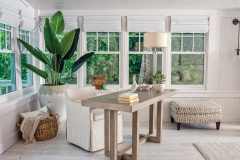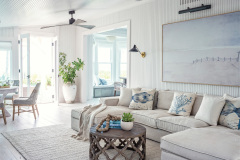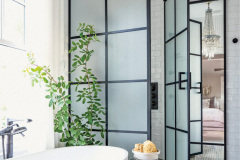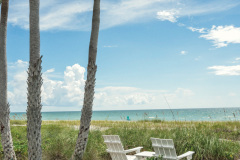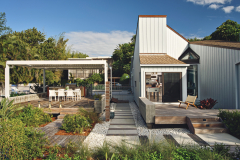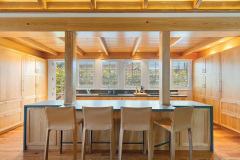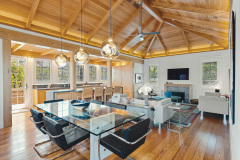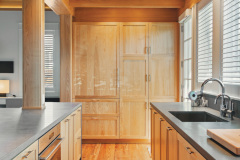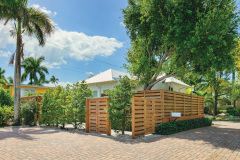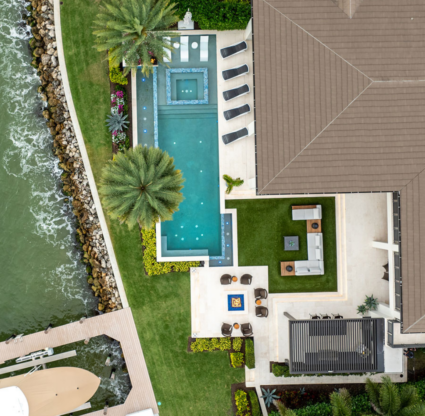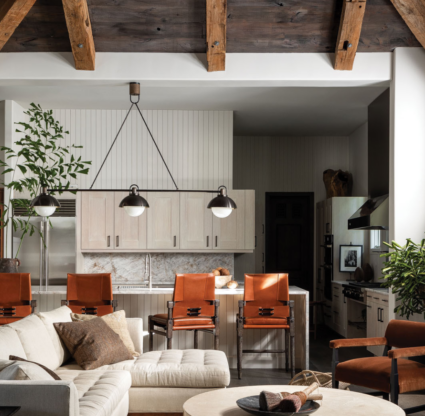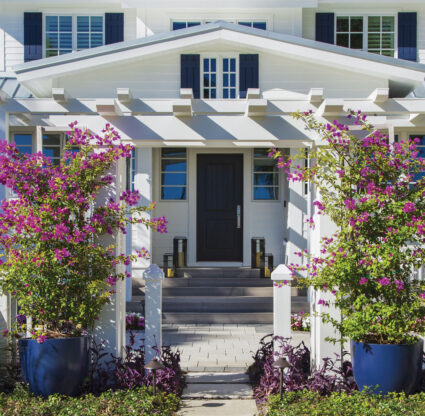“Every generation aspires to something grander than what they grew up with; they want to emulate the things they admire,” Naples interior designer Richard Geary says. “When we’re kids, we all want to live in a castle, and when we’re adults, we want to feel like we’ve arrived.” That’s his theory behind the decades-long trend of building large homes along the beach: owners, especially in retirement, crave a grand dwelling as a reward for their hard work.
But there’s a countervailing idea, driven by an appreciation for history and a desire for simplicity: to seek out smaller homes, more reminiscent of the Florida beach cottages of the early 1900s. “Naples was originally a fishing community, and the modest homes the fishermen lived in are what give western Florida its charm; I love that it’s not a bunch of concrete boxes like Miami,” Geary says.
The classic Florida cottage is often a small one- or two-bedroom home with an angled tin roof and wide porches, and it’s uniquely suited to the climate, architect Joyce Owens explains: “The high-pitched roof allows heat to rise, while the cooler air moves below. The porches and overhangs protect windows and doors from direct sun.”
That’s not to say a beach cottage can’t be luxurious—Geary and Owens each have projects that prove this.
Geary recently completed a gut renovation of a 1920s Bermuda-style house in downtown Naples. “My client saw the house before anybody touched it and wanted to preserve as much as possible,” he says. “Her children are gone, and she does a lot of traveling; she wanted something very small that wouldn’t take much to take care of.” With less than 1,000 square feet, the one-bedroom feels spacious due to its open layout. The house had to be more or less rebuilt from the foundation up to abide by current codes and FEMA standards.
Beyond raising the structure and installing a new metal roof, Geary updated every surface: the floors are made from reclaimed river pine—a period nod—and the ceilings are finished in milled cypress; the air conditioning flows through vents cut into the wooden planks. “We didn’t want to put in a bunch of metal grills because they would have looked like postage stamps up there,” Geary says, noting that hidden LED lights showcase the wood. He fashioned a sleek kitchen, in similar wood tones, with ample discreet storage. Outside, he added a pergola to an existing deck to create a shady space for dining and entertaining and built an enclosed lounging deck for relaxation.
This client downsized, allowing her to edit down to a selection of prized furnishings. Among them are 1920 Ludwig Mies van der Rohe dining chairs and a Dakota Jackson coffee table from the same era (the glass surfaces swing around on the pedestal), a Mies van der Rohe accent chair from the early 1930s, an Achille Castiglioni lamp from the 1950s, a Bauhaus rug from Anni Albers and Donald Judd pieces on the walls. “They were all carefully curated from her other house; she whittled it down to just 10 percent of the best,” Geary says. “We wanted to prove that you could have a modern lifestyle in an earlier style of architecture.”
Owens was enlisted to renovate two beach cottages on Captiva Island over the last few years: a 1912 two-bedroom and a 1970s Charles Moore-designed abode. Each offered an opportunity to marry period details with modern conveniences.
For the first home, much of what Owens did was undo the work completed over the past decades; she replaced uneven floors and moved walls to improve the flow between choppy spaces that had been added. She replaced the roof, windows and shutters with new versions in the same style, improving functionality while maintaining charm. The interiors were updated in a modern palette of whites and grays—which doesn’t distract from vistas of the dunes and Gulf of Mexico. “It’s really all about the beach and opening up the views,” Owens says.
In the 1970s Charles Moore home, the interplay between home and landscape was already a priority, with different interior areas connected by outdoor walkways surrounding a courtyard. Here, Owens’ task was similar—to bring the home up to date visually and structurally, and focus on letting light in and improving the flow, while preserving the modernist’s unique architectural style.
Creating usable, shaded outdoor areas and natural breezeways was paramount for both spaces. “These homes are built to suit the climate, to face everyday heat and searing sun, to withstand torrential rain in the summer,” she says. A smaller, well-built home that makes use of a good cross breeze requires less air conditioning, she says, and the more shaded, comfortable outdoor spaces you have outside, the less need there is for interior square footage.
Of course, there are non-architectural reasons to keep an older structure—the first Captiva cottage, for example, was grandfathered into a location closer to the dunes than what new codes allow. Conversely, not all older homes are in a condition for renovation. “There are very few original Florida beach cottages left—some are barely standing and the tin roofs are rusted; not all of them would make sense to renovate,” Owens says. “If the foundation is not sound, it’s not salvageable.”
Geary and Owens express gratitude and pride that three Florida cottages they recently renovated—with their classic architecture, and up-to-date foundations, roofs and windows—weathered Hurricane Ian. It’s a credit to both smart construction and luck, but also the original designs of the homes themselves. In style and scale, they’re made to withstand the harshest Florida elements.
As our region rebuilds and reinvests, we can reflect on how homes capture the essence of living in Southwest Florida. Even within a smaller footprint, there’s a chance to appreciate the picturesque landscapes and beautiful climate. More and more, Geary says, “We’re recognizing the value of previous generations.”
Photography courtesy: Dan Cutrona; Richard Geary Design/Ryan Gamma Photography; Joshua Colt Fisher; Michael Stavaridis



